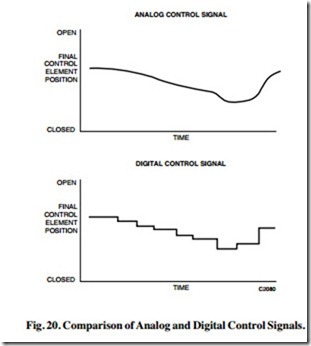ANALOG AND DIGITAL CONTROL
Traditionally, analog devices have performed HVAC control. A typical analog HVAC controller is the pneumatic type which receives and acts upon data continuously. In a pneumatic controller, the sensor sends the controller a continuous pneumatic signal, the pressure of which is proportional to the value of the variable being measured. The controller compares the air pressure sent by the sensor to the desired value of air pressure as determined by the setpoint and sends out a control signal based on the comparison.
The digital controller receives electronic signals from sensors, converts the electronic signals to digital pulses (values), and performs mathematical operations on these values. The controller reconverts the output value to a signal to operate an actuator. The controller samples digital data at set time intervals, rather than reading it continually. The sampling method is called discrete control signaling. If the sampling interval for the digital controller is chosen properly, discrete output changes provide even and uninterrupted control performance.
Figure 20 compares analog and digital control signals. The digital controller periodically updates the process as a function of a set of measured control variables and a given set of control algorithms. The controller works out the entire computation, including the control algorithm, and sends a signal to an actuator. In many of the larger commercial control systems, an electronic-pneumatic transducer converts the electric output to a variable pressure output for pneumatic actuation of the final control element.
